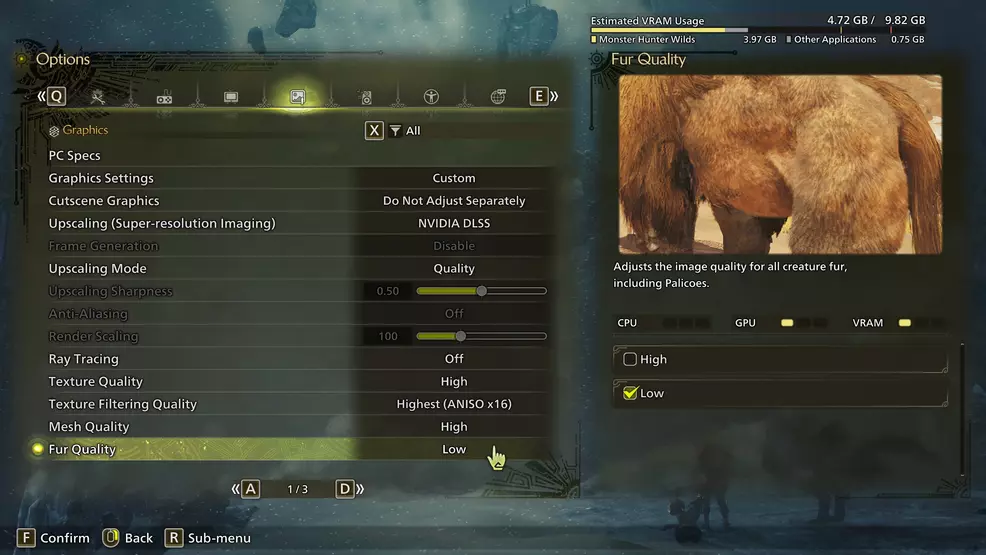Monster Hunter Wilds PC performance guide
Fix the PC performance of Monster Hunter Wilds by tweaking a few key features in-game.
Monster Hunter Wilds is a massive game and as such, it can be quite demanding on computers, even those that meet the recommended specs. Capcom has put out a few tips to fix the PC performance of Monster Hunter Wilds, which is especially useful for those encountering launching issues, sound and cutscene problems, and even FPS hiccups.
Monster Hunter Wilds – PC performance tips
Before diving into any PC performance tips for Monster Hunter Wilds, it’s important to note that this information can be general and may or may not solve your particular problem. Remember you can always issue a ticket via the Monster Hunter Wilds support page to get further help from Capcom.

Source: Capcom
The official Monster Hunter support page offers a few basic tips to help improve your performance:
- Check you meet the recommended specs
- Check for updates for your GPU, DirectX, and Windows
- Perform a clean installation of your video drivers if problems persist
- Add Monster Hunter Wilds and Steam to your anti-virus whitelist
- Run Steam and Monster Hunter Wilds in admin mode
- Verify the game files on Steam
To verify Monster Hunter Wilds on Steam, right click the game and select Properties. Under the Installed Files tab, select Verify integrity of game files. This process will take a few minutes and if it finds any errors or missing files, it will redownload them.
Capcom also suggests disabling Compatibility Mode for Monster Hunter Wilds. Find where you installed Monster Hunter Wilds (Right-click the game, select Manage, and then Browse local files) and then right-click the game’s .exe file and go to Properties. Open the Compatibility tab and untick “Run this program in compatibility mode”. If this doesn’t work, do the same for the Steam.exe.
Monster Hunter Wilds – Graphic settings tips
Monster Hunter Wilds is a resource-hungry beast and unless you have cutting edge hardware, your game is likely to struggle. A few people in the community have come up with some ways to eke out a few more frames and better performance by tweaking some of the graphical settings in-game.

Source: Shacknews
One such set of recommendations comes from huy98vn who developed the Wilds REshade – Subtle Enhancements mod. In the posting on NexusMods, they have the following recommendations:
- Upscaling Mode: DLSS Quality
- Ray Tracing: Off
- Texture Quality: High or Medium
- Mesh Quality: High or Medium
- Fur Quality: Low
- Sky/Cloud Quality: Lowest
- Grass/Tree Quality: Low
- Grass/Tree Sway: Enable
- Sand/Snow Quality: Lowest
- Water Effects: Enable
- Render Distance: Medium
- Shadow Quality: High
- Distant Shadow Quality: Low
- Shadow Distance: Far
- Ambient Light Quality: Low
- Contact Shadows: Enable
- Ambient Occlusion (SSAO): Medium
- Bloom: High
- Motion Blur: Off
- Vignette Effects: Off
- Screen Space Reflection: On
- SSSS Scattering: On
- Depth of Field: Off
- Volumetric Fog: Low
- Variable Rate Shading: Off
- Framegen: Off
Using these settings myself, I could maintain a consistent frame rate and Monster Hunter Wilds still looked great. Obviously, you can change any of these however you please if something doesn’t quite look up to your standards – especially if you’d prefer to have the high resolution texture pack installed.
Those are some of the Monster Hunter Wilds PC performance fixes we’ve found across the internet. We’ll be sure to update this piece if we find other ways to get more frames. For now, try some of these and see how you go. We’ve got more Monster Hunter Wilds content so spend some time looking over the topics page for additional help.
-
Sam Chandler posted a new article, Monster Hunter Wilds PC performance guide


